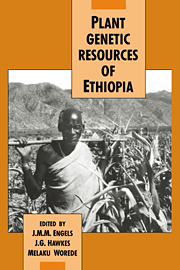Book contents
- Frontmatter
- Contents
- Contributors
- List of acronyms
- Preface
- Part I General introduction
- Part II The Ethiopian centre of diversity
- 2 The Ethiopian gene centre and its genetic diversity
- 3 Crops with wild relatives found in Ethiopia
- 4 Diversity of the Ethiopian flora
- 5 Forest genetic resources of Ethiopia
- 6 Plants as a primary source of drugs in the traditional health practices of Ethiopia
- 7 Traditional aromatic and perfume plants in central Ethiopia (a botanical and ethno-historical survey)
- 8 Spice germplasm in Ethiopia
- 9 A diversity study in Ethiopian barley
- 10 Sorghum history in relation to Ethiopia
- 11 Prehistoric Ethiopia and India: contacts through sorghum and millet genetic resources
- 12 Konso agriculture and its plant genetic resources
- Part III Germplasm collection and conservation in Ethiopia
- Part IV Evaluation and utilization of Ethiopian genetic resources
- Index
12 - Konso agriculture and its plant genetic resources
Published online by Cambridge University Press: 30 October 2009
- Frontmatter
- Contents
- Contributors
- List of acronyms
- Preface
- Part I General introduction
- Part II The Ethiopian centre of diversity
- 2 The Ethiopian gene centre and its genetic diversity
- 3 Crops with wild relatives found in Ethiopia
- 4 Diversity of the Ethiopian flora
- 5 Forest genetic resources of Ethiopia
- 6 Plants as a primary source of drugs in the traditional health practices of Ethiopia
- 7 Traditional aromatic and perfume plants in central Ethiopia (a botanical and ethno-historical survey)
- 8 Spice germplasm in Ethiopia
- 9 A diversity study in Ethiopian barley
- 10 Sorghum history in relation to Ethiopia
- 11 Prehistoric Ethiopia and India: contacts through sorghum and millet genetic resources
- 12 Konso agriculture and its plant genetic resources
- Part III Germplasm collection and conservation in Ethiopia
- Part IV Evaluation and utilization of Ethiopian genetic resources
- Index
Summary
Introduction
Konso is the name of a relatively small area (approximately 500 sqkm) situated in south-west Ethiopia at a latitude of 5°15’ N and a longitude of 37°30'E, which is populated mainly by the Konso people. The topography is characterized by rugged and stony highlands, cut by deep valleys that enter into the heart of the country. The main agricultural area ranges in altitude from 1400 to 2000 m above sea level and the climate is of the dry montane type with temperatures ranging from below 15 °C at night to 32 °C during the day at the hottest time of the year. The Konso Highlands run across the Rift Valley in an east-west direction and are situated in the dry belt of Ethiopia with an unreliable rainfall not exceeding 800 mm per year. There are two rainy seasons: the big rains are concentrated in March and April and the small rains fall around October and November. In general, the rains come in the form of violent thunderstorms which seldom last more than two hours (Hallpike, 1972). The Sagan River forms the eastern and southern borders of Konso, while to the north the great plains of Gomida and Lake Shamo and, more to the west, the Gidole mountains and the Woito Valley form natural boundaries.
The Konso are a small tribe of about 60000 people (Minker, 1986). Their language belongs to the East Cushitic group (Hallpike, 1970).
- Type
- Chapter
- Information
- Plant Genetic Resources of Ethiopia , pp. 169 - 186Publisher: Cambridge University PressPrint publication year: 1991
- 5
- Cited by

